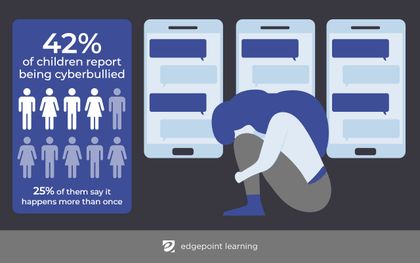Your Guide To Cyberbullying Training For Teachers And Schools
Corey Bleich
🍿 5 min. read
Before digital media, bullies in school focused on their targets in person. Teachers and schools could witness the bullying and take steps to prevent it during the school day. Cyberbullying has taken school-day bullying to the next level, however, seeping into evenings and weekends and making it harder for schools to intervene. But cyberbullying training for teachers can change all of that, creating a safe, supportive environment for all kids—even after school hours. Here's how to roll out this type of training for your teachers and administrative staff.
What is cyberbullying?
Cyberbullying occurs when a person uses any type of digital media (i.e., texts, social media sites, email, etc.) to harass, demean, belittle, and otherwise intimidate another person. Cyberbullying can be something like a string of negative emails or trolling a person’s social media with incendiary or demeaning comments.
More than teasing, the Cyberbullying Research Center defines a cyberbully as someone who “repeatedly harasses, mistreats, or makes fun of another person” online.
Even though it is generally conducted outside of school hours, cyberbullying often makes its way into the classroom. Scholastic cites the following statistics on cyberbullying among student populations:
- 42%: The percentage of kids who report being cyberbullied (and 25% of them say it happens more than once)
- 21%: Those who are cyberbullied via mean or threatening email or text
- 58%: Kids who keep the cyberbullying from their parents
- 14%: Children who are the target of mean comments on social media
- 13%: Kids who report being bullied by rumors online

With nearly half of all kids being cyberbullied (and many not reporting these incidents to parents), teachers must be vigilant and ready to respond to cyberbullying in schools. These bullying incidents may occur at night, but the fallout can spill into the school day.
As 83% of girls and 79% of boys report being bullied either in person or online, anti-bullying training for teachers should be a top priority for new and veteran teachers and staff.
How cyberbullying training for teachers can help prevent issues
Think about it: children from kindergarten to college spend more time in school throughout the year than they do awake in the presence of their parents or caregivers. Parents may not always spot the signs of their child being bullied. If it truly takes a village to raise a child, then parents and schools can work together to keep kids safe, both in person and online.
Cyberbullying training for teachers and other school staff trains personnel to recognize the signs of bullying and prevent escalation. Working with parents and other community members to create multi-tiered systems of support (MTSS) is one research-based approach that starts with a wide lens of universal prevention before zooming in to targeted prevention and resolution.
Another research-based strategy focuses on a student’s moral engagement with the people around them. When students understand their own worth and are able to commit to positive behavior and care for other people, then the incidence of bullying behavior goes down. Think that moral development isn’t the job of the schools? While it’s true that teachers and staff are not parents—the traditional transmitters of values—the demographics of families are changing. Working with parents, teachers can reinforce the lessons that start at home to promote kind, ethical behavior.
This type of training benefits all—students, teachers, parents, and community members. Anti-bullying training for teachers gives them the tools they need to nurture productive, compassionate members of society.
What does a cyberbullying for teachers program need to include?
It's a rare person who would argue that nurturing caring community members in and out of the classroom is a bad thing, but teachers are arguably the most pressed for time of any group of workers. A cyberbullying training for teachers needs to be simultaneously wide-ranging and laser-focused to fit into their current time demands.
Here’s how to roll-out cyberbullying training for teachers:
- Include only relevant topics
- Identify trainees
- Create simulations for "real-life" experiences
- Teach the basics on how to handle and report issues
Include only relevant topics
Start with narrowing down to the relevant topics for your training. Consider including the following:
- Recognizing the signs of bullied students
- Defining a teacher’s role in preventing and reporting bullying
- Identifying ways to work moral engagement into daily lessons
This is just the beginning, and every school will have different needs. Good training designs begins with a training needs analysis that will help your school figure out exactly where to start.
Identify trainees
Teachers are not the only adults in a school building. From support staff to the cleaning crew and all the way to the principal, everyone plays a role in preventing bullying in and out of school.
If the most pressing need is in the classroom, start there, but be prepared to branch out.
Create simulations for “real-life” experience
Cyberbullying training for teachers is designed by adults for adults. This makes sense, but at some point in the training, teachers will need to know the language of online bullying.
Learning acronyms and slang is an important part of any effective anti-bullying training. Simulations can help put theory into practice and assist teachers in identifying and responding to bullying.
Teach basics on how to handle and report issues
On a practical level, teachers need to know how to handle issues in their classrooms and how to report them. Many schools have tiers of escalating response that includes discipline and action in the classroom, on a school-wide level, and then finally up to a district (or criminal) response. If teachers are not made aware of these levels (and the support resources that exist for them as they proceed), they may put themselves and the school at risk.
It’s also important to keep in mind that teachers have one of the most important and complex jobs and very little time to do it. Cyberbullying training for teachers has to be relevant, efficient, and delivered in easy-to-digest-and-apply chunks. This might mean designing a microlearning lesson to deliver bite-sized pieces of information and resources.
How we help
Cyberbullying training for teachers is an important part of a teacher's professional development nowadays. With the Alaska Department of Education and Early Development (DEED), EdgePoint Learning helped develop a series of courses to help their teachers stay up-to-date on their training needs. With this eLearning option, teachers could take their training when and where it made most sense for them.
When you are ready to get started with your own program, contact EdgePoint Learning. Whether you need to expand or update an existing training or design a new one from the ground up, we can help!
